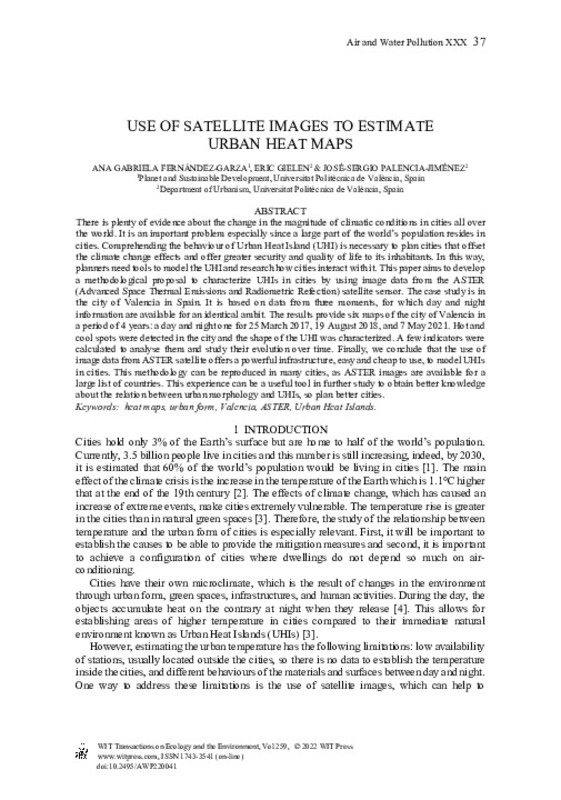JavaScript is disabled for your browser. Some features of this site may not work without it.
Buscar en RiuNet
Listar
Mi cuenta
Estadísticas
Ayuda RiuNet
Admin. UPV
Use of satellite images to estimate urban heat maps
Mostrar el registro sencillo del ítem
Ficheros en el ítem
| dc.contributor.author | Fernández-Garza, Ana Gabriela
|
es_ES |
| dc.contributor.author | Gielen, Eric
|
es_ES |
| dc.contributor.author | Palencia-Jiménez, José-Sergio
|
es_ES |
| dc.date.accessioned | 2023-02-24T19:01:25Z | |
| dc.date.available | 2023-02-24T19:01:25Z | |
| dc.date.issued | 2022 | es_ES |
| dc.identifier.uri | http://hdl.handle.net/10251/192073 | |
| dc.description.abstract | [EN] There is plenty of evidence about the change in the magnitude of climatic conditions in cities all over the world. It is an important problem especially since a large part of the world¿s population resides in cities. Comprehending the behaviour of Urban Heat Island (UHI) is necessary to plan cities that offset the climate change effects and offer greater security and quality of life to its inhabitants. In this way, planners need tools to model the UHI and research how cities interact with it. This paper aims to develop a methodological proposal to characterize UHIs in cities by using image data from the ASTER (Advanced Space Thermal Emissions and Radiometric Refection) satellite sensor. The case study is in the city of Valencia in Spain. It is based on data from three moments, for which day and night information are available for an identical ambit. The results provide six maps of the city of Valencia in a period of 4 years: a day and night one for 25 March 2017, 19 August 2018, and 7 May 2021. Hot and cool spots were detected in the city and the shape of the UHI was characterized. A few indicators were calculated to analyse them and study their evolution over time. Finally, we conclude that the use of image data from ASTER satellite offers a powerful infrastructure, easy and cheap to use, to model UHIs in cities. This methodology can be reproduced in many cities, as ASTER images are available for a large list of countries. This experience can be a useful tool in further study to obtain better knowledge about the relation between urban morphology and UHIs, so plan better cities. | es_ES |
| dc.description.sponsorship | This research was funded by Planet and Sustainable Development Chair (Cátedra Planeta y Desarrollo Sostenible) of the Universitat Politècnica de València. | es_ES |
| dc.language | Inglés | es_ES |
| dc.publisher | WIT Press | es_ES |
| dc.relation.ispartof | WIT Transactions on Ecology and the Environment (Online) | es_ES |
| dc.rights | Reserva de todos los derechos | es_ES |
| dc.subject | Heat maps | es_ES |
| dc.subject | Urban form | es_ES |
| dc.subject | Valencia | es_ES |
| dc.subject | ASTER | es_ES |
| dc.subject | Urban Heat Islands | es_ES |
| dc.subject.classification | URBANISTICA Y ORDENACION DEL TERRITORIO | es_ES |
| dc.title | Use of satellite images to estimate urban heat maps | es_ES |
| dc.type | Artículo | es_ES |
| dc.identifier.doi | 10.2495/AWP220041 | es_ES |
| dc.rights.accessRights | Abierto | es_ES |
| dc.contributor.affiliation | Universitat Politècnica de València. Escuela Técnica Superior de Ingenieros de Caminos, Canales y Puertos - Escola Tècnica Superior d'Enginyers de Camins, Canals i Ports | es_ES |
| dc.description.bibliographicCitation | Fernández-Garza, AG.; Gielen, E.; Palencia-Jiménez, J. (2022). Use of satellite images to estimate urban heat maps. WIT Transactions on Ecology and the Environment (Online). 259:27-49. https://doi.org/10.2495/AWP220041 | es_ES |
| dc.description.accrualMethod | S | es_ES |
| dc.relation.publisherversion | https://doi.org/10.2495/AWP220041 | es_ES |
| dc.description.upvformatpinicio | 27 | es_ES |
| dc.description.upvformatpfin | 49 | es_ES |
| dc.type.version | info:eu-repo/semantics/publishedVersion | es_ES |
| dc.description.volume | 259 | es_ES |
| dc.identifier.eissn | 1743-3541 | es_ES |
| dc.relation.pasarela | S\472188 | es_ES |
| dc.contributor.funder | Cátedra Planeta y Desarrollo Sostenible, Universitat Politècnica de València | es_ES |
| dc.subject.ods | 11.- Conseguir que las ciudades y los asentamientos humanos sean inclusivos, seguros, resilientes y sostenibles | es_ES |
| dc.subject.ods | 13.- Tomar medidas urgentes para combatir el cambio climático y sus efectos | es_ES |








